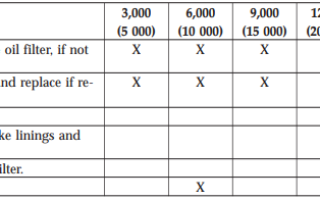EMISSION CONTROL SYSTEM MAINTENANCE
The “Scheduled” maintenance services, listed in bold type must be done at the times or mileages specified to assure the continued proper functioning of the emission control system. These, and all other maintenance services included in this manual, should be done to provide best vehicle performance and reliability. More frequent maintenance may be needed for vehicles in severe operating conditions such as dusty areas and very short trip driving. Inspection and service also should be done any time a malfunction is suspected.
NOTE: Maintenance, replacement, or repair of the emission control devices and systems on your vehicle may be performed by any automotive repair establishment or individual using any automotive part, which has been certified pursuant to U.S. EPA or, in the State of California, California Air Resources Board regulations.
MAINTENANCE SCHEDULES
NOTE:
• For vehicles equipped with a 2.7L engine, follow Schedule “A” or “B” from 0 to 150,000 miles (0 to 250 000 km).
• For vehicles equipped with a 3.5L or 5.7L engine, follow Schedule “A” or “B” from 0 to 120,000 miles (0 to 200 000 km).
There are two maintenance schedules that show the required service for your vehicle. First is Schedule “B.” It is for vehicles that are operated under the conditions that are listed below and at the beginning of the schedule. Change the automatic transmission fluid and filter every 60,000 miles (100 000 km) if the vehicle is usually operated under one or more of the conditions marked with an .
• Day or night temperatures are below 32°F (0°C).
• Stop and go driving
• Extensive engine idling.
• Driving in dusty conditions.
• Short trips of less than 10 miles (16 km).
• More than 50% of your driving is at sustained high speeds during hot weather, above 90°F (32°C).
• Trailer towing.
• Taxi, police, or delivery service (commercial service).
• Off-road or desert operation.
NOTE: If ANY of these apply to you, then change your engine oil every 3,000 miles (5 000 km) or 3 months, whichever comes first, and follow the maintenance recommendations in Schedule “B” in this section.
NOTE: If ANY of these apply to you, then flush and replace the engine coolant every 102,000 miles (170 000 km) or 60 months, whichever comes first, and follow the maintenance recommendations in Schedule “B” in this section.
NOTE: Most vehicles are operated under the conditions listed for Schedule B. Second is Schedule “A.” It is for vehicles that are not operated under any of the conditions listed under Schedule B. Use the schedule that best describes your driving conditions. Where time and mileage are listed, follow the interval that occurs first.
NOTE: Under no circumstances should oil change intervals exceed 6,000 miles (10 000 km) or 6 months whichever comes first.
CAUTION!
Failure to perform the required maintenance items may result in damage to the vehicle.
At Each Stop for Fuel
• Check the engine oil level about 5 minutes after a fully warmed engine is shut off. Checking the oil level while the vehicle is on level ground will improve the accuracy of the oil level reading. Add oil only when the level is at or below the ADD or MIN mark.
• Check the windshield washer solvent and add if required.
Once a Month
• Check tire pressure and look for unusual wear or damage.
• Inspect the battery, and clean, and tighten the terminals as required.
• Check the fluid levels of coolant reservoir and brake master cylinder, and add as needed.
• Check all lights and all other electrical items for correct operation.
• Check rubber seals on each side of the radiator for proper fit.
At Each Oil Change
• Change the engine oil filter.
• Inspect the exhaust system.
• Inspect the brake hoses.
• Inspect the CV joints and front and rear suspension components.
• Check the coolant level, hoses, and clamps.
SCHEDULE “B”
Follow Schedule “B” if you usually operate your vehicle under one or more of the following conditions. Change the automatic transmission fluid and filter every 60,000 miles (100 000 km) if the vehicle is usually operated under one or more of the conditions marked with an .
• Day or night temperatures are below 32°F (0°C).
• Stop and go driving.
• Extensive engine idling.
• Driving in dusty conditions.
• Short trips of less than 10 miles (16 km).
• More than 50% of your driving is at sustained high speeds during hot weather, above 90°F (32°C).
• Trailer towing.
• Taxi, police or delivery service (commercial services).
• Off-road or desert operation.
NOTE: If ANY of these apply to you, then change your engine oil every 3,000 miles (5 000 km) or 3 months, whichever comes first, and follow the maintenance recommendations in Schedule “B” in this section.
NOTE: If ANY of these apply to you, then flush and replace the engine coolant every 102,000 miles (170 000 km) or 60 months, whichever comes first, and follow the maintenance recommendations in Schedule “B” in this section.









* This maintenance is recommended by the manufacture to the owner but is not required to maintain the emissions warranty.
‡ This maintenance is not required if previously replaced. Inspection and service should also be performed anytime a malfunction is observed or suspected. Retain all receipts.
SCHEDULE “A”





* This maintenance is recommended by the manufacturer to the owner but is not required to maintain the emissions warranty.
‡ This maintenance is not required if previously replaced. Inspection and service should also be performed anytime a malfunction is observed or suspected. Retain all receipts.
WARNING!
You can be badly injured working on or around a motor vehicle. Only do service work for which you have the knowledge and the right equipment. If you have any doubt about your ability to perform a service job, take your vehicle to a competent mechanic.







